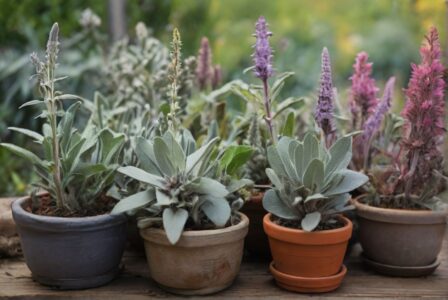- Introduction
- Advantages of mixed cultivation
- The best plant combinations for your flower bed
- Plants that you should avoid planting next to each other
- Conclusion and further tips
1. introduction
Mixed cultivation, a gardening technique in which different plants grow together in one bed, promotes the Biodiversity and enlivens the garden. It attracts insects such as bees, which help with pollination, and prevents the spread of diseases and pests [1]. This system makes optimum use of the nutrients in the soil and prevents their depletion [1]. Knowledge of good and bad plant combinations is crucial to fully exploit the benefits of mixed cultivation [1].
In this article, we take a deep dive into the world of mixed cultivation, highlighting its benefits and presenting the best plant combinations, with a special focus on Zucchinipeppers, eggplants and many more. You will also find out which plants you should avoid planting next to each other to ensure healthy growth and a rich harvest [1][6].
2. advantages of mixed cultivation
Mixed cultivation offers numerous benefits to the garden that go far beyond simple diversification of plant species. Some of the key benefits include:
- Improved soil fertilityThe combination of different plant species strengthens the soil structure and promotes biological activity, resulting in improved soil fertility [10].
- Increased YieldsDiversity of plants leads to more efficient use of soil nutrients and resources, which in turn can increase yields [10][12].
- Natural Pest control and disease resistanceBy strategically placing plants that repel or are unattractive to certain pests, intercropping can help reduce the use of chemical pesticides. In addition, healthy plant interactions can reduce the risk of disease [10][12].
These synergies make mixed cultivation an effective strategy to maximize the health and productivity of the garden while reducing the ecological footprint.
3. the best plant combinations for your bed
Successful plant combinations are the key to a healthy and productive garden. Here are some Proven combinations:
- Tomatoes thrive well with Kohlrabi, garlic or cabbageas these plants repel each other's pests and promote growth [14].
- Cucumbers benefit from the proximity to Dill and borageas these improve the germination capacity and provide shade for the dill [15].
- Carrots and Bulbous plants are a beneficial combination, as onions repel the carrot fly and carrots repel the onion fly [15].
In addition Beans and Savory a great combination, as savory repels the black bean aphid and promotes bean growth [15]. Celery and Cabbage also complement each other well, as celery repels cabbage flies and cabbage worms, while cabbage supports the growth of celery [15]. It is important to select suitable plant partners and plant them in the same bed to utilize their compatible growth forms and monitor their growth [3].
4. plants that you should avoid planting next to each other
Some plant combinations that should be avoided include:
- Potatoes and Peas or beansThis combination can lead to growth disorders, as they require similar nutrients and are susceptible to the same pests [9].
- Tomatoes and FennelBoth plants can hinder each other's growth, as fennel excretes substances that can inhibit the growth of tomatoes [18].
- Cabbages and GarlicAlthough garlic can repel many pests, it is not compatible with cabbage species as it can negatively affect their growth [21].
It is important to consider the specific needs and growth forms of each plant in order to achieve a harmonious mixed crop. Selecting plants that get on well together not only promotes healthy growth, but can also improve crop yields.
5 Conclusion and further tips
By delving into the practices of mixed cropping and its many benefits, from improving soil fertility to natural pest control, we have seen how important it is to think carefully about combining plants in our gardens. The combinations presented, from tomatoes with kohlrabi to carrots with onion crops, offer a practical guide to maximizing garden productivity and health, taking into account Environmental friendliness and sustainability. At the same time, the discussion about plant combinations that should be avoided reminds us of the subtle but crucial interactions between different plant species.
In conclusion, the findings on mixed cultivation reflect a deeper appreciation for the complexity and potential of our gardens. It becomes clear that consciously planning and nurturing our plant relationships not only improves yields, but also promotes a healthier, more resilient ecosystem. In addition, the information presented encourages further exploration and experimentation with mixed crops in our own garden projects. As gardeners, we have the opportunity to not only thrive through our conscious interaction with nature, but also to make a positive contribution to our planet.
FAQs
Which vegetables should not be planted together in the garden bed?
Care should be taken not to plant certain vegetables together in order to avoid growth problems. These include combinations of tomatoes with cucumbers, fennel, peas or potatoes; radishes or radishes with cucumbers; leeks with bush beans, beet, peas or runner beans; celery with lettuce, corn or potatoes; and onions with cabbage, bush beans or runner beans.
Which plant combinations are suitable for mixed cultivation in the garden?
The following plant combinations are particularly suitable for successful mixed cultivation in the garden: cucumbers with dill and borage; beans with savory; lettuce with peas; garlic with strawberries; carrots with onion plants; marigolds with potatoes; and nasturtiums with pumpkin plants.
Which plants affect each other's growth?
Some plant combinations can have a negative effect on the growth of the other plant. These include beans with peas or leeks or onions; peas with onions; cucumbers with cress, radish or tomatoes; potatoes with onions; lettuce with cress, parsley or celery; and beet with carrots or tomatoes.
Which plants harmonize with each other in the bed?
The question of harmonizing plant combinations in the bed refers to the successful formation of mixed cultures in which certain plants promote each other's growth. The combinations mentioned above, such as cucumbers with dill and borage or carrots with onion plants, are examples of such harmonious partnerships in the garden.
References
[1] – https://www.beetfreunde.de/mischkultur-im-garten/
[2] – https://www.oekom.de/beitrag/wie-funktioniert-mischkultur-planung-abstaende-nachbarn-101
[3] – https://www.mein-schoener-garten.de/themen/mischkultur
[4] – https://www.naturgartenideen.de/natur-gartenplaner/mischkultur/vorteile-der-mischkultur/
[5] – https://www.pflanzenforschung.de/de/pflanzenwissen/lexikon-a-z/mischkultur-1044
[6] – https://www.plantura.garden/gartenpraxis/mischkultur/mischkultur
[7] – https://oscorna.de/gartenwissen/mischkultur/
[8] – https://www.smarticular.net/mischkultur-im-gemuesegarten-beispiele-gute-nachbarn/
[9] – https://www.olerum.de/auf-gute-nachbarn-richtige-mischkultur-im-garten
[10] – https://www.bioaktuell.ch/pflanzenbau/ackerbau/mischkulturen/vorteile-und-nachteile-von-mischkulturen
[11] – https://www.quarks.de/umwelt/landwirtschaft/so-nachhaltig-sind-mischkulturen/
[12] – https://www.landwirtschaft.de/landwirtschaft-erleben/garten-und-balkon/selbst-anbauen/mischkultur-im-garten
[13] – https://www.wurzelwerk.net/gemuesegarten/pflanzplan-erstellen/mischkultur/
[14] – https://www.t-online.de/heim-garten/garten/id_86114632/wenn-pflanzen-sich-helfen-diese-vorteile-bringt-mischkultur-im-gemuesebeet.html
[15] – https://www.plantura.garden/gartenpraxis/mischkultur/pflanzenkombinationen-fuer-mischkulturen
[16] – https://www.giftfreiesgaertnern.de/wissensplattform/wissenswertes/mischkulturen/
[17] – https://www.krautundrueben.de/mischkultur-welche-gemuese-passen-zusammen-2797
[18] – https://www.obi.de/magazin/garten/pflanzen/gemuesepflanzen/welche-pflanzen-vertragen-sich-tabelle
[19] – https://www.merkur.de/leben/wohnen/wohnen-garten-gemuese-beet-mischkultur-gemuesesorten-sollten-keinesfalls-nebeneinander-pflanzen-zr-12854857.html
[20] – https://www.samenhaus.de/gartenblog/mischkultur-im-garten-auf-gute-nachbarschaft
[21] – https://www.ndr.de/ratgeber/garten/gartentipp313.pdf
[22] – https://einfaches-gaertnern.de/gartenwissen/mischkultur-anlegen/
















